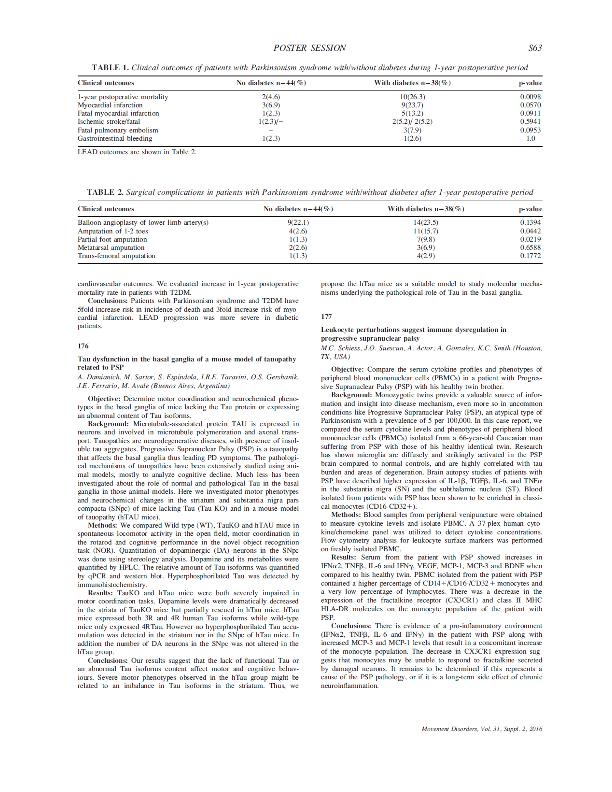Evento
Tau dysfunction in the basal ganglia of a mouse model of tauopathy related to PSP
Damianich, Ana ; Sartor, Manuela
; Sartor, Manuela ; Espindola, Sonia Lorena
; Espindola, Sonia Lorena ; Taravini, Irene Rita Eloisa
; Taravini, Irene Rita Eloisa ; Gershanik, Oscar Samuel; Ferrario, Juan Esteban
; Gershanik, Oscar Samuel; Ferrario, Juan Esteban ; Avale, Maria Elena
; Avale, Maria Elena
 ; Sartor, Manuela
; Sartor, Manuela ; Espindola, Sonia Lorena
; Espindola, Sonia Lorena ; Taravini, Irene Rita Eloisa
; Taravini, Irene Rita Eloisa ; Gershanik, Oscar Samuel; Ferrario, Juan Esteban
; Gershanik, Oscar Samuel; Ferrario, Juan Esteban ; Avale, Maria Elena
; Avale, Maria Elena
Tipo del evento:
Congreso
Nombre del evento:
20th International Congress on Parkinson's Disease
Fecha del evento:
19/06/2016
Institución Organizadora:
International Parkinson and Movement Disorder Society;
Título de la revista:
Movement Disorders Society
Editorial:
International Parkinson and Movement Disorder Society
ISSN:
1531-8257
Idioma:
Inglés
Clasificación temática:
Resumen
Objective: Determine motor coordination and neurochemical phenotypes in the basal ganglia of mice lacking the Tau protein or expressing an abnormal content of Tau isoforms.Background: Microtubule-associated protein TAU is expressed in neurons and involved in microtubule polymerization and axonal transport. Tauopathies are neurodegenerative diseases, with presence of insoluble tau aggregates. Progressive Supranuclear Palsy (PSP) is a tauopathy that affects the basal ganglia thus leading PD symptoms. The pathological mechanisms of tauopathies have been extensively studied using animal models, mostly to analyze cognitive decline. Much less has been investigated about the role of normal and pathological Tau in the basal ganglia in those animal models. Here we investigated motor phenotypes and neurochemical changes in the striatum and substantia nigra pars compacta (SNpc) of mice lacking Tau (Tau KO) and in a mouse model of tauopathy (hTAU mice).Methods: We compared Wild type (WT), TauKO and hTAU mice in spontaneous locomotor activity in the open Öeld, motor coordination in the rotarod and cognitive performance in the novel object recognition task(NOR). Quantitation of dopaminergic (DA) neurons in the SNpc was done using stereology analysis.Dopamine and its metabolites were quantiÖed by HPLC. The relative amount of Tau isoforms was quantiÖed by qPCR and western blot. Hyperphosphorilated Tau was detected by immunohistochemistry.Results: TauKO and hTau mice were both severely impaired in motor coordination tasks. Dopamine levels were dramatically decreased in the striata of TauKO mice but partially rescued in hTau mice. hTau miceexpressed both 3R and 4R human Tau isoforms while wild-type mice only expressed 4RTau. However no hyperphosphorilated Tau accumulation was detected in the striatum nor in the SNpc of hTau mice. In additionthe number of DA neurons in the SNpc was not altered in the hTau group.Conclusions: Our results suggest that the lack of functional Tau or an abnormal Tau isoforms content affectmotor and cognitive behaviours. Severe motor phenotypes observed in the hTau group might be related to animbalance in Tau isoforms in the striatum.Thus, we propose the hTau mice as a suitable model to study molecular mechanisms underlying the pathological role of Tau in the basal ganglia.
Palabras clave:
TAU
,
MOTOR COORDINATION
,
FRONTOTEMPORAL DEMENTIA
,
COVID-19
Archivos asociados
Licencia
Identificadores
Colecciones
Eventos(INGEBI)
Eventos de INST.DE INVEST.EN ING.GENETICA Y BIOL.MOLECULAR "DR. HECTOR N TORRES"
Eventos de INST.DE INVEST.EN ING.GENETICA Y BIOL.MOLECULAR "DR. HECTOR N TORRES"
Eventos(SEDE CENTRAL)
Eventos de SEDE CENTRAL
Eventos de SEDE CENTRAL
Citación
Tau dysfunction in the basal ganglia of a mouse model of tauopathy related to PSP; 20th International Congress on Parkinson's Disease; Berlín; Alemania; 2016; 1-1
Compartir



